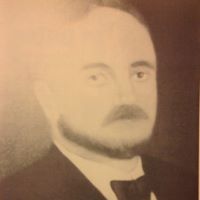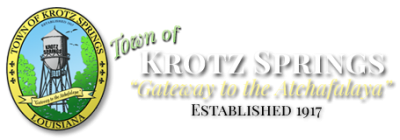Town History
The history of Krotz Springs as a community begins at the turn of the century with the coming to St. Landry Parish of Col. Charles W. Krotz. C.W. Krotz was born in 1856 in Defiance, Ohio and arrived in this area in 1899. In 1900 Col. Krotz drilled the first oil well in the Parish (possibly the first in the state). At 2400 feet, instead of striking oil, he struck an artesian well of terrific pressure. Undaunted, C.W. Krotz bottled his water and touted Krotz Springs as "The Coming Health Resort of the South." Krotz claimed the water was good for many ailments, including stomach, kidney and bowel trouble and indigestion. He claimed it would cure rheumatism, would dissolve and remove gall stones and gravel from the bladder and was a cure for malaria. He called it the "finest bathing water in the world."
Krotz also informed the Krotz Springs Hotel Co., Ltd. and began selling lots in the area. The first lots were sold for $100 according to a 1909 map of Krotz Springs. After the first 100 lots were sold, lots would only be sold for $150 to $200 according to his advertisement. Being the entrepreneur that he was, he also offered terms to suit purchasers.
Determined that his community would have a school, students first attended class in a one room "section house." Many felt that Krotz's attempt at a school was a foolhardy venture especially with only 10 pupils attending. However, by 1909 there were eighteen or twenty families well established in Krotz Springs and the town began to take shape.
In 1909, the railroad came to Krotz Springs. The railroad crossing was completed over the Atchafalya in 1910. It was said that it was largely attributable to Krotz's management that the deal with the Gulf Coast Lines for use of the Krotz Springs Railroad Bridge was entered into.
In 1916 Krotz sold 5.65 acres to the Parish School Board for $900. The School Board sold $12,000 in bonds to build the school in Krotz Springs. A two-story brick school was built on the site for the sum of $7,821. Krotz entered into an agreement to sell water to the school from his well for $50 a year for a ten year period.
In 1917 Krotz attempted to incorporate Krotz Springs. He had failed to incorporate it in 1915 under the name Latanier. The postal service had failed to accept the name for the community. A community of Latanier already existed in Rapides Parish. The name was changed to Krotz Springs and was officially incorporated as a village on January 6, 1917.
C.W. Krotz died December 17, 1925 and is buried in Krotz Springs in the St. Anthony Catholic Church Cemetery that he and his family donated in 1920. Krotz never lived to witness the event that would assure the survival of Krotz Springs as a community. 1932-33 brought the construction of the Huey Long-O.K. Allen highway bridge over the Atchafalaya River at Krotz Springs. It is said that it was through Col. Krotz' untiring efforts that Route 7, known as the East and West highway was definitely determined on.
According to the Saturday, December 19, 1925 edition of the CLARION-PROGRESS, Opelousas, Louisiana, his obituary reads, "Col. C.W. Krotz in the face of great handicaps and difficulties won a high place at an early age in the business world. Deprived of a college education, he was nevertheless one of the best informed men in this area in business affairs and financial topics of national interest. He had a boundless and irrepressible faith in the Town of Krotz Springs and in the future and in the medicinal efficacy of the mineral water. He was a builder, doer, a constructor, and it is wonderful to contemplate his accomplishments in view of this lack of funds and resources.
For more information on the history of Krotz Springs, Volume I, II, and III books can be purchased at town hall.

CW Krotz

